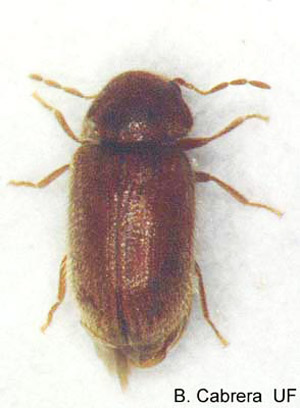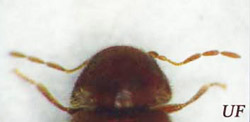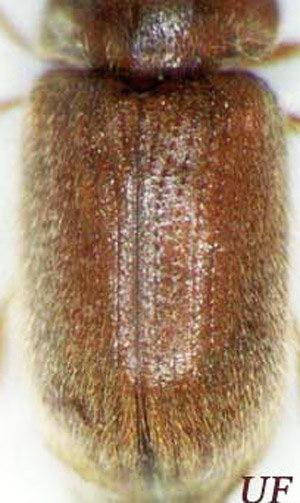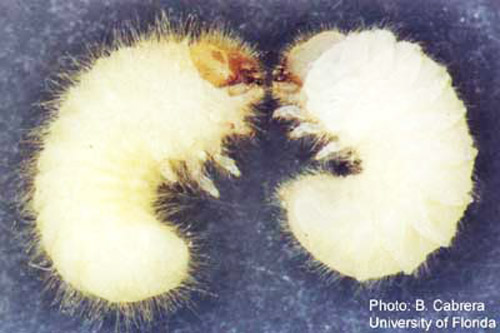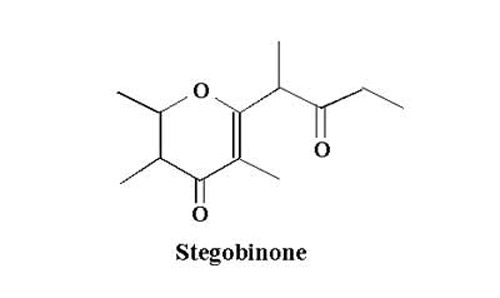common name: drugstore beetle
scientific name: Stegobium paniceum (Linnaeus) (Insecta: Coleoptera: Anobiidae)
Introduction - Distribution - Description and Identification - Life History - Pest Status - Management - Natural Enemies - Chemical Ecology - Selected References
Introduction (Back to Top)
There are over 1000 described species of anobiids. Many are wood borers, but two, the drugstore beetle, Stegobium paniceum (L.) (known in the United Kingdom as the biscuit beetle) and the cigarette beetle, Lasioderma serricorne (F.) (also known as the tobacco beetle), attack stored products. Stored product pests cause tremendous damage and economic losses to post-harvest and stored grains and seeds, packaged food products, and animal and plant-derived items and products. Besides causing direct damage by feeding, they elicit disgust, annoyance, and anger in many of those who find them infesting these products.
Figure 1. Adult drugstore beetle, Stegobium paniceum (L.). Photograph by B.J. Cabrera, University of Florida.
Distribution (Back to Top)
Drugstore beetles have a worldwide distribution, but are more abundant in warmer regions or in heated structures in more temperate climates. They are less abundant in the tropics than the cigarette beetle.
Description and Identification (Back to Top)
Adults: The beetles are cylindrical, 2.25 to 3.5 mm (1/10 to 1/7 inch) long, and are a uniform brown to reddish brown. They have longitudinal rows of fine hairs on the elytra (wing covers). Drugstore beetles are similar in appearance to the cigarette beetle; however, two physical characters can be used to tell the difference between them. The antennae of the cigarette beetle are serrated (like the teeth on a saw) while the antennae of the drugstore beetle are not and end in a 3-segmented club. The other difference is that the elytra (wing covers) of the drugstore beetle have rows of pits giving them a striated (lined) appearance while those of the cigarette beetle are smooth.
Figure 2. Serrated antennae of a cigarette beetle, Lasioderma serricorne (F.), (left); and clubbed antennae of a drugstore beetle, Stegobium paniceum (L.) (right). Photograph by B.J. Cabrera, University of Florida.
Figure 3. Striated elytra of an adult drugstore beetle, Stegobium paniceum (L.). Photograph by B.J. Cabrera, University of Florida.
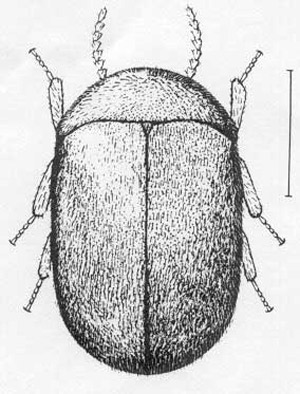
Figure 4. Comparison of the elytra and antennae of the cigarette beetle, Lasioderma serricorne (F.), (left); and drugstore beetle, Stegobium paniceum (L.) (right). Drawings by Division of Plant Industry.
Larvae: Small, white grubs; the later instars are scarab-like. They are similar to cigarette beetle larvae, but have shorter hairs and the marking on the head ends in a straight line across the frons just above the mouthparts.
Figure 5. Larva of the drugstore beetle, Stegobium paniceum (L.). Photograph by B.J. Cabrera, University of Florida.
Figure 6. Comparison of a larva of a cigarette beetle, Lasioderma serricorne (F.), (left); and the drugstore beetle, Stegobium paniceum (L.) (Right). Photograph by B.J. Cabrera, University of Florida.
Life History (Back to Top)
Females lay up to 75 eggs in the food or substrate. The larval period ranges from four to 20 weeks. Larvae tunnel through the substrate and when fully grown build a cocoon and pupate. Pupation takes from 12 to 18 days. Adult females live approximately 13 to 65 days. The entire life cycle is generally less than two months but can be as long as seven months. The duration of the life cycle is highly dependent on the temperature and food source. Development occurs between 60 to 93°F (~15 to 34°C) but is optimal at about 85°F (~30°C) and 60 to 90% relative humidity.
Pest Status (Back to Top)
The drugstore beetle attacks such a wide variety of foods and material that one anonymous quote states that it "eats anything but cast iron." It gets its name from its habit of feeding on prescription drugs. It also feeds on flours, dry mixes, breads, cookies, chocolates and other sweets, and spices. Non-food material includes wool, hair, leather, horn, and museum specimens. It is found in pigeon nests and is known to bore into books, wooden objects, and, in some cases, tin or aluminum foil and lead sheets. Larval feeding accounts for the greatest amount of damage. Museum and herbarium specimens are vulnerable to attack. Slight damage and contamination can ruin these valuable and priceless items. Drugstore beetles harbor symbiotic yeasts that produce B vitamins. The yeasts are deposited on the eggs as they pass through the oviduct and are consumed by the larvae during egg hatch. These yeasts enable the drugstore beetle to feed and survive on many foods and other items of poor nutritional quality.
Management (Back to Top)
Home. Preventing and controlling drugstore beetle infestations is relatively simple: Insecticides should be used only as a last resort. Locating the source or sources of infestation is the first and most important step. Heavily infested items should be wrapped in heavy plastic, taken outside and thrown away. All food containers and items should be checked for infestation. Items can be placed in the refrigerator or freezer (16 days at 36°F or seven days at 25°F) to kill all stages. Place the items in a plastic bag to reduce condensation problems during thawing. Heating small quantities of infested material (190°F for one hour, 120°F for 16 to 24 hours) in an oven is also effective. Uninfested items can be cold- or heat-treated to ensure that any undetected stages are killed.
To prevent reinfestation, clean up spilled flour, mixes, crumbs, etc. and thoroughly vacuum and clean areas where the contaminated items were stored. Store foods in airtight glass, metal or plastic containers. Clear containers make it easier to check for infestation. Chemical treatment using commercially available insecticides or insect growth regulators is usually not necessary but if used, be sure to follow the label.
Insect Management Guide for pantry and stored food pests
Commercial. The drugstore beetle is a common pest of processed and packaged food products. It is found in flour mills, bakeries, pet food, breakfast cereal manufacturing, and snack food plants, chocolate factories, confectionaries, wholesale distribution centers and sometimes retail stores. Integrated pest management (IPM) programs are often implemented to control infestations at processing, distribution, and storage facilities.
Large-scale control for severe infestations can be achieved by fumigation. However, the use of one fumigant, methyl bromide -- which destroys ozone in the atmosphere -- was banned in 2005 according to an addition to the Montreal Protocol (an international agreement signed by over 150 countries) in 1995. Heat treatment has been used with limited success. Effective control is obtained when a temperature of approximately 50°C (122°F) is maintained for 24 to 36 hours.
Residual insecticides registered for use on drugstore beetles can be applied to cracks, crevices and shelves in storage areas after removal of stored products (check labels for specific use). Insect growth regulators (IGRs) may be used as part of an IPM program. Sticky traps baited with the female sex pheromone, stegobinone, can be used to monitor for adult beetles. Mass-trapping -- which involves setting out large numbers of traps in infested areas with the intent of catching large numbers of beetles to reduce the population -- has been tried, but effectiveness is limited because only males are attracted to the traps. For mass trapping of drugstore beetles to succeed, a large enough number of males must be caught to ensure that few females will be mated. Pheromone traps are mostly used for detecting and monitoring beetle populations. The traps typically are set out in a grid-like pattern within a facility and monitored at regular intervals for trapped males. If one or more traps in a particular area happen to catch a greater proportion of beetles, then more traps are set out in that area to pinpoint the source of infestation.
Insect Management Guide for pantry and stored food pests
Natural Enemies (Back to Top)
The drugstore beetle is attacked by a variety of generalist natural enemies. Predators include Tenebriodes sp. (Tenebrionidae), Thaneroclerus sp. (Cleridae) and several carabids. Eggs may be eaten by predatory mites. Parasitoids include wasps in the families Pteromalidae, Eurytomidae and Bethylidae. However, biological control for stored-product pests has not been widely adopted. Part of the problem is that although it reduces the amount of pesticides used for control, the release of beneficial insects to control stored-product pests increases the total amount of insects and insect parts in foodstuffs.
Chemical Ecology (Back to Top)
The drugstore beetle sex pheromone, stegobinone (2,3-dihydro-2,3,5-trimethyl-6-(1-methyl-2-oxobutyl)-4H-pyran-4-one) is used in commercially available traps and lures. Stegobinone has also been identified as the sex pheromone of a wood-feeding anobiid, the common furniture beetle, Anobium punctatum. Wind-tunnel assays in one study revealed that male furniture beetles were attracted to female drugstore beetle extracts. Thus, stegobinone-baited lures can be marketed for two different pest species. Stegobinone has also been tentatively identified as the sex pheromone of two other wood-destroying anobiids from the mid-Pacific coast of North America, Hemicoelus gibbicollis and Ptilinus basalis.
Figure 7. Chemical structure of stegobinone, a sex pheromone of the drugstore beetle, Stegobium paniceum (L.). Graphic by B.J. Cabrera, University of Florida.
Selected References (Back to Top)
- Baur FJ. 1991. Chemical methods to control insect pests of processed foods. pp. 427-440. In Gorham JR (ed.), Ecology and Management of Food-Industry Pests. FDA Technical Bulletin 4.
- Granovsky TA. Stored product pests. pp. 635-728. In Moreland D (ed.), Handbook of Pest Control (by Mallis A), Eighth Edition. Mallis Handbook and Technical Training Co.
- Hill DS. 1990. Pests of stored products and their control. CRC Press, Boca Raton. 274 pp.
- Howe RW. 1957. A laboratory study of the cigarette beetle, Lasioderma serricorne (F.)(Col., Anobiidae) with a critical review of the literature on its biology. Bulletin of Entomological Research 48: 9-56.
- Krischik V, Burkholder W. 1995. Stored-product insects and biological control agents. pp. 85-102. In Krischik V, Cuperus G, Galiart D (eds.) Stored product management. Oklahoma Cooperative Extension Service Circular Number E-912.
- Phillips TW. 1994. Pheromones of stored-product insects: current status and future perspectives. pp. 479-486. In Highley E, Wright EJ, Banks HJ, Champ BR (eds.), Proceedings of the 6th International Working Conference on Stored-product Protection, Vol. 1. CAB International, Wallingford, U.K.
- Philips TW. 1997. Semiochemicals of stored-product insects: Research and applications. Journal of Stored Product Research 33: 17-30.
- Phillips TW, Berberet RC, Cuperus GW. 2000. Postharvest integrated pest management, pp. 2690-2701. In Francis FJ (ed.), The Wiley Encyclopedia of Food Science Technology, 2nd Edition. John Wiley and Sons, New York.
- Phillips TW, Cogan PM, Fadamiro HY. 2000. Pheromones, pp. 273-302. In Subramanyam B, Hagstrum DW (eds.), Alternatives to pesticides in stored-product IPM. Kluwer Academic Publishers, Boston.
- United States Department of Agriculture. 1980. Stored-grain insects. USDA-ARS Agriculture Handbook Number 500, 57 pp.
- White PR, Birch MC. 1987. Female sex pheromone of the common furniture beetle Anobium punctatum (Coleoptera: Anobiidae): Extraction, identification and bioassays. Journal of Chemical Ecology 13: 1695-1706.
